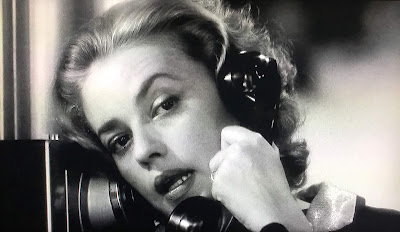In
the fall of 1957, Louis Malle brought together a skilled crew that carried out
a brazen and successful caper in the center of Paris.
Malle, then a documentary filmmaker, and his friend the novelist Roger Nimier stylized a potboiler roman policier into a true crime narrative of a Perfect Crime gone awry. Unlike the potboiler, Malle and Nimier’s story revolves around the lightly made-up face of Jeanne Moreau filmed by master cinematographer Henri Decaë using Tri-X film in natural light, mostly at night. Decaë had shot Bob le Flambeur for Jean-Pierre Melville in 1956. François Truffaut used him for Les quatre-cent coups in 1959.
Moreau
was at the time an accomplished stage actress of the Comédie-Française
unremarkable in about two dozen films. Her character and perhaps her film stardom
was born the moment she raised an eyebrow in a close-up while talking with her
lover on the telephone during the film’s title sequence.
Malle, then a documentary filmmaker, and his friend the novelist Roger Nimier stylized a potboiler roman policier into a true crime narrative of a Perfect Crime gone awry. Unlike the potboiler, Malle and Nimier’s story revolves around the lightly made-up face of Jeanne Moreau filmed by master cinematographer Henri Decaë using Tri-X film in natural light, mostly at night. Decaë had shot Bob le Flambeur for Jean-Pierre Melville in 1956. François Truffaut used him for Les quatre-cent coups in 1959.
 |
|
Elevator to the Gallows revolves around Jeanne
Moreau’s lightly made-up face.
|
 |
|
Florence’s
raised eyebrow launches Jeanne Moreau’s movie stardom.
|
The
diverse cast and extras appear in the film less as ‘characters’ than as people
one might see in a documentary or in still photography of the period. Each of
them draws the viewer’s attention because we sense that we are watching their
lives. As Barbet Schroeder later said of his and Eric Rohmer’s directing work:
‘You are hanging out with people and it’s their life you are watching. The
movie-making is only an abstraction. It’s their life you are watching and you
want to make your audience a participant.’
 |
|
A barstool storyteller intrigues Florence
(Jeanne Moreau) in Elevator to the
Gallows.
|
And
then jazz trumpeter Miles Davis and Paris-based musicians whom the film
producers brought together for the project responded musically to the finished
film. Davis’s improvised score, a blue mood that finds melodies in E minor
without harmonic movement, was a first for the movies. It helped Davis find his
way to the new sound he achieved in Kind of Blue about a year later (1959).
 |
|
Jeanne Moreau watches Miles Davis, bassist
Pierre Michelot, and tenor sax Barney Wilen develop Davis’s score for Elevator to the Gallows.
|
In
the end, Malle’s stars and those of the crew he brought together lined up so
well that they pulled off a marvelous caper: the director’s first feature film,
Ascenseur pour l’échafaud—Elevator to the Gallows.
Part
of the trick was making a drama look like a documentary. There are technical,
forensic, and legal details over which one can quibble; but Moreau, the film’s
mood, the lovely shots and montage, the cast, and Davis’s score make the
audience a participant and are a testament to the caper’s success. Malle and
his crew made a great picture.
 |
|
Julien (Maurice Ronet) does not reflect in
the elevator in Elevator to the Gallows.
|
The
story is simple. Julien Tavernier (Maurice Ronet), a former Foreign Legion
officer and veteran of the wars in Vietnam and Algeria, is the right hand of
arms dealer Simon Carala (Jean Wall). But Julien and Carala’s young wife
Florence (Moreau) plot to stage Carala’s suicide and live happily ever after.
Julien sets about this task with military efficiency on a Saturday morning.
 |
|
Louis
(Georges Poujouly) admires his blouson
noir in a window in Elevator to the
Gallows.
|
Louis
(Georges Poujouly), a blouson-noir or
James Dean-style Parisian ‘juvenile delinquent’ in a black leather jacket,
admires himself in the window of the flower shop where his girlfriend Véronique
(Yori Bertin) works. The shop is across the street from Carala’s office. Véro
is helping to close the shop on Saturday afternoon. Louis notices that someone
left a fancy 1952 Chevrolet Styleline convertible idling on the curb outside
the shop.
 |
|
Véronique (Yori Bertin) joyrides with Louis
(Georges Poujouly) in Elevator to the
Gallows.
|
Julien
is on the elevator to the gallows. Florence sees his convertible fly by where
she is waiting for him, but with the silly flower shop girl in the passenger
seat. She assumes that Julien is the driver. Having no idea what happened at
the office—and of course no cell phone—she sets off on a disconsolate all-night
walk about Paris filmed in sequences of long tracking shots.
 |
|
Florence (Jeanne Moreau) loses herself in
Paris’s night streets in Elevator to the
Gallows.
|
 |
| Jeanne Moreau in the ambient light of Paris at night in Elevator to the Gallows. |
Inspector
Chérier (Lino Ventura) is called to investigate a murder at a modish motel
where well-heeled clientele arrange assignations and no one is in a hurry to
cooperate. And Julien finds himself back on the street.
 |
|
Some shots and sequences in Elevator to the Gallows tip a hat to
Alfred Hitchcock.
|
 |
|
Other shots mimic the classic Paris
photography of Brassaï, Cartier-Bresson, Doisneau.
|
These
vignettes intimate the chain of personal catastrophes set in motion. It will
take the inspector and his assistant (Charles Denner) until the film’s end to
wrap up the loose ends in a photography darkroom.
 |
|
Inspector
Chérier (Lino Ventura) plays good-cop with Florence (Jeanne Moreau).
|
Ascenseur pour l’échafaud (Elevator to the Gallows) 1958 France (91
minutes) Gaumont/Criterion. Directed by Louis Malle; screenplay by Roger Nimier
and Malle, based on a novel by Noël Calef; cinematography by Henri Decaë;
edited by Léonide Azar; music by Miles Davis.


No comments:
Post a Comment